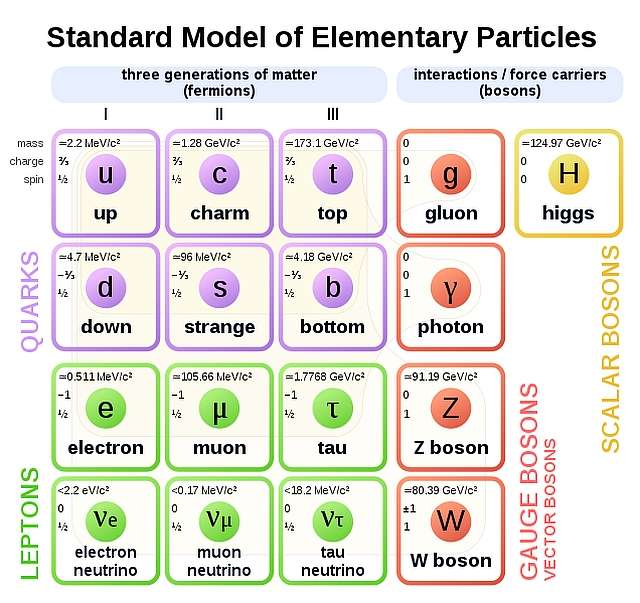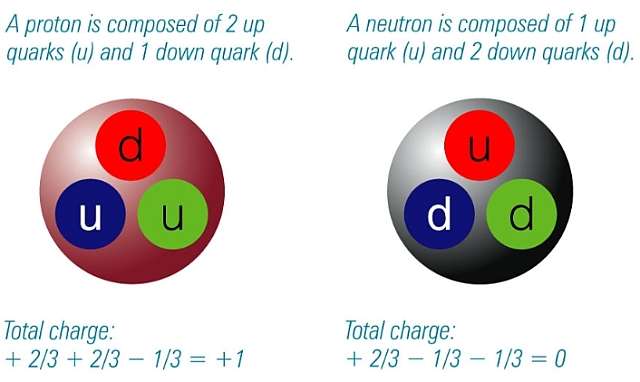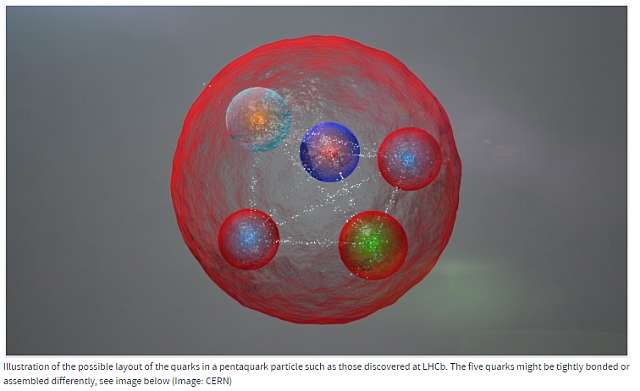"Physicists have finally figured out how pentaquarks are built
Scientists pinpoint the structure of the five-quark particles
BY EMILY CONOVER 6:00AM, JUNE 7, 2019
To make a quark quintet, combine a trio and a duo.
Exotic subatomic particles called pentaquarks contain five smaller particles called quarks and antiquarks. But those particles aren’t a simple clump of five constituents rattling around. Instead, the pentaquarks are molecule-like agglomerations of a pair of smaller particles, each of which consists of either three quarks or a quark and an antiquark, scientists report in the June 7 Physical Review Letters.
First spotted in 2015 at the Large Hadron Collider in Geneva, pentaquarks were unlike anything seen before (SN: 8/8/15, p. 8). All previous known quark-containing particles were either baryons — particles such as protons and neutrons which contain three quarks — or mesons, which consist of one quark and one antiquark. But pentaquarks, with their five component particles, didn’t fit into either of those categories.
“There was no clear picture how these pentaquarks were built,” says particle physicist Tomasz Skwarnicki of Syracuse University in New York, a coauthor of the study.
Some scientists thought that the pentaquarks’ five constituents could mingle on an equal footing. But detailed measurements from the LHCb experiment reveal that the pentaquarks are made from two known particles, a baryon and a meson, stuck together. That finding makes the particles a bit less exotic than had been speculated.
Still, Skwarnicki says, the result reveals new facets of particle physics: Before this result, it wasn’t clear that baryons and mesons could glom onto one another at all."
A quick recap:
In the Standard Model of Elementary Particles there's up and down, charm and strange, and top and bottom quarks:

Protons and neutrons, which form the nuclei of atoms in varying numbers, are composed of three quarks each. In the case of a proton, of two up quarks and one down quark, whereas for a neutron it's one up quark and two down quarks:

A single proton has one elementary charge, determined as recently as this year as 1.602176634×10−19 C (whereby C stands for Coulomb, the SI unit of electric charge; FYI, the charge carried by a constant current of one Ampère in one second).
Up quarks carry two thirds of a (positive) elementary charge and a down quark one third of a negative charge, so that a proton has an electrical charge equal to 2/3 e + 2/3 e - 1/3 e = 4/3 e - 1/3e = 1e.
Similarly, a neutron is electrically neutral since the charge of the one up quark (+ 2/3e) is neutralized by the negative charges of the two down quarks (2/3e - 2 x 1/3e = 0 e).
Protons and neutrons are baryons, from the Greek word for 'heavy' and quite stable. An electron, with a negative charge of minus one elementary charge (-e) is not a baryon but a lepton, from the Greek word for 'light', and indeed, if Outlaw's memory does not betray him, I still hear my old physics teacher say that its mass is about 1/2000th of the mass of a proton. In the meantime, I think I came across a more specific value of 1/1854th or something but whatever, it is much, much lighter than a proton. Within the current model it is not known whether it can be split up further like protons and neutrons and an electron is therefore truly an elemental particle. Electrons too are inherently stable.
Mesons are quite another matter. They are composed of one quark and one antiquark which stick together because of the strong nucelar force (one of the four fundamental interactions). Since quarks have a size, mesons have size too, in effect a diameter of roughly one femtometer (1 x 10 to the minus 15 meter), which is about 1.2 times the size of a proton or neutron. Mesons are inherently unstable, with the longest-lived lasting for only a few hundredths of a microsecond.
And now there's pentaquarks, composed of a baryon and a meson!

(illustration via CERN)
An interesting resume by Dr Don Lincoln:
Fascinating!
MFBB.